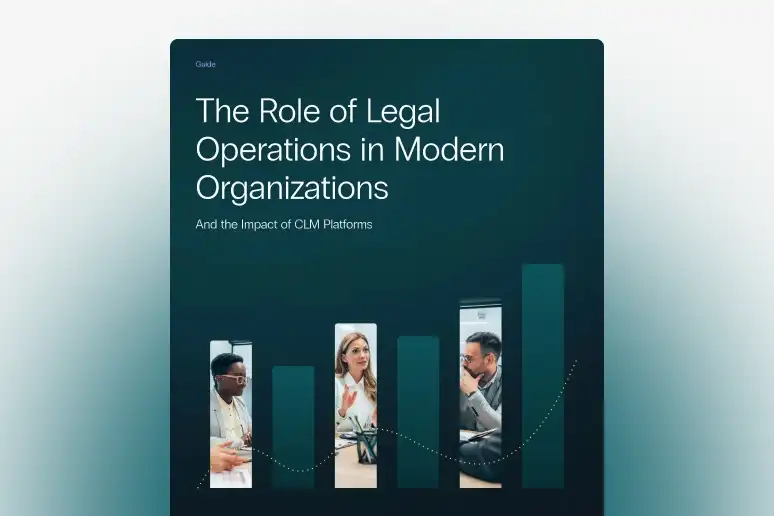Legal Ops Best Practices to Solve Contract Management Issues

- Last Updated: Nov 12, 2025
- 15 min read
- Sirion
Building out a solid legal operations function is a challenging task. From hiring the right team members to planning your strategy, there are a lot of factors to consider.
That’s especially true when it comes to solving contract management issues. The last thing you’ll want to do is waste time and effort setting up processes and workflows that don’t have a real impact on your team. And we don’t want that either.
That’s why we’re giving you some best practices for legal contract management to tackle your contracting issues and get your in-house legal team running like a fine-tuned machine.
Before we dive into specific best practices, let’s first clarify what legal contract management really means—and why it plays such a central role in legal operations.
What Is Legal Contract Management?
Legal contract management is the end-to-end process of creating, reviewing, negotiating, executing, storing, and tracking contracts—managed either by the legal department or with their close involvement. It ensures that contracts are not just compliant and risk-mitigated but also aligned with business goals and operational workflows.
This includes:
- Drafting legally sound agreements using standardized language
- Collaborating with internal teams like sales, procurement, and finance
- Ensuring contract compliance throughout the lifecycle
- Managing renewals, obligations, and version control
- Using technology such as contract lifecycle management (CLM) tools to automate workflows and improve visibility
In legal operations, contract management is a core pillar because it directly impacts deal velocity, risk posture, and overall business efficiency.
Why Is Legal Contract Management Important?
Contracts are the foundation of every business relationship—and mismanaging them can lead to costly delays, missed obligations, and regulatory risks. That’s why legal contract management is more than just paperwork; it’s a strategic function.
Here’s why it matters:
- Reduces Legal Risk: Ensures compliance with legal terms, privacy regulations, and internal policies.
- Improves Business Efficiency: Automates routine tasks, accelerates deal cycles, and frees up legal resources.
- Strengthens Collaboration: Enables seamless workflows between Legal, Sales, Procurement, and other departments.
- Delivers Strategic Insights: Provides data on contract performance, clause usage, and negotiation trends.
- Supports Growth: Scales contract operations as businesses expand, without compromising control or visibility.
Strong legal contract management empowers legal ops to be proactive, not just reactive—managing risk while enabling business.
Now that we’ve covered what legal contract management entails and why it’s a vital function, let’s explore the best practices Legal operations team can adopt to solve contracting issues and build more agile, scalable processes.
What Are the Best Practices of Legal Contract Management?
Each Legal Operations team has its own goals and focuses. Your biggest challenge may be streamlining contract creation. In another business, Legal Operations may need to improve data management for better collaboration with other internal teams. Still, no matter your goals, these tips will help you prioritize your legal operations tasks and build out workflows that support your unique objectives.
Here are best practices for Legal Operations contract management:
Contract Centralization & Standardization
The first step in solving contract management issues is getting your documents—and your processes—in order. Centralizing contracts and establishing standardized templates and protocols lays the foundation for automation, compliance, and efficiency.
1. Centralize Your Contracts
Before you can optimize your legal contract management process, you need to get all your documents in one place.
Gather your contracts from your various ERP, CRM, Finance, and IT platforms and local storage drive. Don’t worry if they’re PDF scans from legacy agreements —AI contract management can ingest and review contracts in any format.
Once all your documents are in a centralized contract repository, your CLM platform can analyze those millions of pieces of contract data. From there, you’re ready to standardize and automate your contract life cycle management.
2. Standardize Your Templates
Think about how long it takes Legal and Legal Ops to author contracts from scratch. Too long.
You can streamline contract creation by developing templates that allow you to author new contracts in seconds. From NDAs and SLAs to employment contracts, you’ll save yourself plenty of time and effort by grabbing those contract templates and editing them as needed.
You can even take it one step further and build out a contract clause library that uses Legal-approved language. Need to add an indemnity clauseto an incoming contract? Search for it using regular language, and it’ll pop up immediately.
3. Set Up Document Management Protocols
Your contracts are living documents that have a big impact on your business. So don’t just toss them into your CLM and forget about them. The right document management protocol ensures your contracts work for you.
For security measures, only a few people in your company need free reign of your entire contract portfolio. Decide who can view and edit certain types of contracts, set those permission controls, and prevent unauthorized access to sensitive data.
From there, you should also use version controls and audit trails to track contracts at every stage. This way, you have a clear line of sight into all communications surrounding each contract, facilitating an effective contract management audit.
Collaboration & Stakeholder Alignment
Legal Ops doesn’t operate in a vacuum. To streamline the contract lifecycle, your workflows must align with other business units. These practices focus on cross-functional collaboration, stakeholder engagement, and internal education to reduce friction and increase adoption.
1. Be Honest About What You Need
As you develop your legal ops function, be careful not to jump into the deep end too quickly. If you try to tackle everything all at once, your team can find themselves stretched too thin and overwhelmed.
Listen to your legal department’s concerns. Speak to the other teams Legal works with. Take note of concerns that continuously come up and prioritize those areas first. Then, build out your strategy from there.
2. Offer Education to Non-Legal Teams
You can set up processes and workflows for forever and a day. Getting the rest of your company on board is a different story entirely.
When it comes to change management, a little explanation goes a long way. Clarify your reasoning for implementing new procedures to other teams. Offer them training on contract management best practices, terms, and compliance issues so they have the knowledge needed to self-service contracts.
Not only does this help streamline contract processes, but it also reduces friction along the way.
3. Collaborate with Your Stakeholders
Any Legal Ops team knows your interactions aren’t limited to just working with the company’s lawyers. So whatever best practices you implement to solve legal contract management issues won’t apply to just Legal either.
Discuss contracting concerns with Sales, Procurement, and IT teams who are also involved in contracting. Use their feedback to influence the decisions you make and streamline processes across your entire company.
Automation & CLM Technology
Manual processes don’t scale. To solve recurring contract challenges and accelerate turnaround times, Legal Ops must lean into automation and CLM tools. These practices show how to make technology work for you—from AI-powered contract review to choosing the right platform.
1. Define Your Contract Review Processes
Contract review is one of the most time-consuming, tedious, and extremely necessary tasks within the contract lifecycle. So, it’s safe to say there is a lot of room for improvement here.
Leverage contract AI to enforce your playbook, get guidance on legal aspects of contract management, and review contracts 80% faster.
To further streamline contract review, build out clear workflows that alert the necessary parties of tasks so you can execute deals efficiently.
2. Do Your Research for CLM Solutions
There are a lot of different contract management software for legal teams out there. Why? Because they all have different capabilities and are training differently. The key is to find the platform that best suits your unique needs.
Do your due diligence when exploring CLM software to solve your legal contract management issues. Ask the right questions about capabilities, security, and AI training to find the solution that best suits your needs.
Continuous Improvement & Metrics
Once your systems are in place, the real work begins: optimizing them over time. These best practices help you define success metrics, measure impact, and continuously refine your contract operations as your business evolves.
1. Measure Metrics That Matter
To ensure the processes you’re putting in place are working, you should take a lot of contract metrics into account—maybe ones you hadn’t even considered.
Are your efforts focusing on vendor and spend management? Of course, you should track external metrics like obligation fulfillment, service levels, and supplier performance.
But you also need to keep track of internal metrics to drive meaningful change in your workflows. Here are some examples to consider:
- Average time to signature — Are contracts getting stuck during negotiation or approval?
- Time spent per contract type — How much legal time is going to NDAs MSAs or renewals?
- % of contracts using standard templates — A low percentage could indicate poor adoption or gaps in your template library.
- Number of bottlenecks by department — Identifying where delays happen helps prioritize automation or training.
You can use this data to continuously refine your legal contract management process, address inefficiencies, and scale smarter.
2. Revisit Your Processes Regularly
What works today may not (probably won’t) work a year from now. As your business evolves, so do your contract management needs—and the processes you use to keep things running smoothly.
Review your processes regularly. It may be every six months or every year. No matter the frequency, identify areas that still work and others that may need updating.
Ready to apply these best practices to your Legal Ops function? Start here.
Getting Started: Legal Ops CLM Checklist
✅ Audit existing contract storage locations
Take stock of where your contracts currently live—shared drives, email threads, legacy systems—and identify gaps in visibility or version control.
✅ Identify recurring issues from legal and cross-functional teams
Gather input from Legal, Sales, Procurement, and Finance to uncover pain points like bottlenecks, delays, or compliance risks in the current contract process.
✅ Create or update templates and clause libraries
Build standardized, legally approved templates and clause libraries to accelerate drafting and ensure consistency across contract types.
✅ Shortlist CLM platforms with AI review features
Evaluate contract lifecycle management platforms that offer AI-powered clause extraction, risk detection, and workflow automation to reduce review time and improve accuracy.
✅ Define performance metrics
Establish key KPIs such as average time to signature, contract volume by type, and compliance rates to track the impact of your legal operations strategy.
✅ Run training sessions for stakeholders
Equip business users with the knowledge to use templates, follow workflows, and self-service simple contracts—minimizing legal review for routine agreements.
This checklist can serve as your action plan to move from insight to implementation—step by step.
Centralize. Standardize. Optimize.
With the right CLM platform, your legal ops team can handle the “how” of contracting so lawyers can focus on the “what” and “why.” Sirion turns every one of your contracts into interactive sources of valuable data and makes it easy to pull any document you need. With our contract management automation, you can smash bottlenecks and limit delays to experience a different type of rush at the end of the quarter. Let’s work together to empower your legal ops team. Get started today.
FAQs: Legal Operations & Contract Management
What’s the difference between legal operations and the legal department?
Legal operations focuses on optimizing how legal services are delivered—through process improvements, technology adoption, and data-driven strategies. The legal department, on the other hand, handles substantive legal work such as drafting, negotiation, compliance, and litigation.
What role does legal operations play in contract risk management?
Legal operations helps proactively identify and mitigate contract risks by standardizing workflows, managing version control, and ensuring proper audit trails. It also supports consistency through clause libraries and playbooks.
How does a CLM platform benefit legal operations beyond contract storage?
Modern CLM platforms offer features like clause extraction, automated approval routing, AI-assisted review, and performance tracking. Legal operations teams can use these tools to streamline the full contract lifecycle and reduce manual workload.
Can legal operations help accelerate sales and procurement cycles
Yes. Legal operations enables faster contract turnaround by supporting self-service contracting, automating approvals, and simplifying redlining processes—removing friction for sales and procurement teams.
How do you justify the ROI of legal operations initiatives?
By measuring improvements in contract cycle times, legal hours saved, compliance rates, and missed renewal reductions. These metrics demonstrate how legal operations drives efficiency and business value.
What should legal operations teams look for when evaluating CLM software?
Key criteria include clause-level AI capabilities, integration with existing business tools (e.g., Salesforce, Workday), customizable workflows, role-based access, and strong vendor support. Scalability and security are also crucial.
Is it possible to start a legal operations function without a large team or budget?
Yes. Many legal operations initiatives begin with simple improvements—like consolidating contracts and using standardized templates—and gradually scale up. Affordable CLM platforms can support lean legal teams with automation and visibility.


